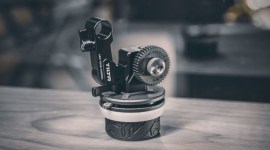
What Is Medium Format and Why Do You Want It for Your Next Camera?
So what exactly does “medium format” mean, and could it be the perfect choice for your next project — or your next camera?
Medium format cameras have started to arrive on the market for digital cinematography applications. This new (yet old) format is finally starting to make its way into video camera manufacturers’ product lineups.
The History of Medium Format

Image via Anton Mukhin.
During the film days of the advertising and commercial world, medium format was king. Being a larger format than traditional 35mm, it made it easier to enlarge an image for a billboard, or maintain quality for print. However, once digital cameras came along, medium format slowly began to fade into obscurity. The only home it found for years was among film purists and analog hobbyists. However, medium format has slowly started to make its way back into the market — this time with digital.
Medium Format vs. Other Formats
The easiest comparison to make for medium format is to its closest counterpart — full frame. Essentially, medium format is any sensor-size exceeding the full-frame size of 24mm x 36mm.
When shooting on film, medium format uses 61mm 120 film. In digital application, this number will vary significantly across different camera manufacturers. For example, Fuji’s upcoming medium format camera offers a 43.8 x 32.9mm sensor, while ARRI’s ALEXA LF, which they dubbed “large format,” offers a 36.70 mm x 25.54 mm sensor.
Advantages of Medium Format
Higher Pixel Density
With a higher pixel density, medium format cameras can record much more color information. This amount of imagery data has more to do with the size of the photo site rather than the number. With this in mind, a 4K image from a medium format sensor will have more information than a 4K image from an APS-C sensor.
As a result, medium format is known for creating the most life-like imagery and color rendition of any format out there because it captures more information per photo site.
Shallower Depth of Field
When the Canon 5D Mark II first came out, many complained that the cameras created a depth of field that was too shallow. As a result, a lot of the imagery was soft since the focus was much tougher to nail. You could make the same argument for medium format. Since it’s a much larger sensor, it’ll create a shallower image at 2.8 than its full-frame counterpart.
However, knowing how to manage and when to use this shallower depth of field can be a strong creative advantage for content-creators.
Medium Format for Digital Cinematography
APS-C and full-frame sensors have reigned as kings among digital cinema cameras. However, we’ve begun to witness medium format making its entry into digital cinema cameras, as camera makers push beyond full-frame. With the upcoming release of the Fuji GFX-100, we’re beginning to see cameras push beyond full-frame and into the next digital frontier.
Cover image via Fujifilm.
Looking for more articles on cameras and gear? Check these out.
- Film vs. Digital: Comparing Medium Format to 35mm to Mirrorless
- The 5 Best Sliders to Pair with Mirrorless Video Cameras
- The Simple, Stable Solution to Rigging Your Lights Anywhere
- Viltrox vs. Metabones: Speed Booster for the Blackmagic Pocket Cinema Camera
- 3 Cheap, Underappreciated Cameras Filmmakers Should Consider






